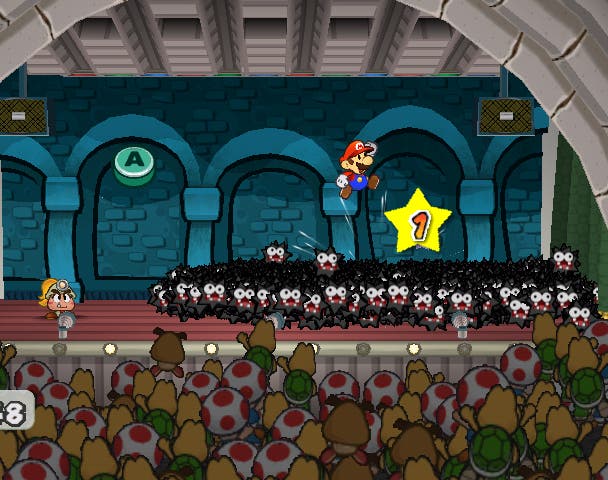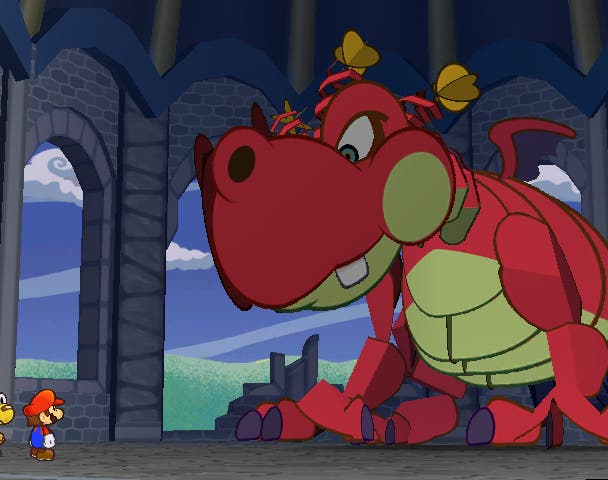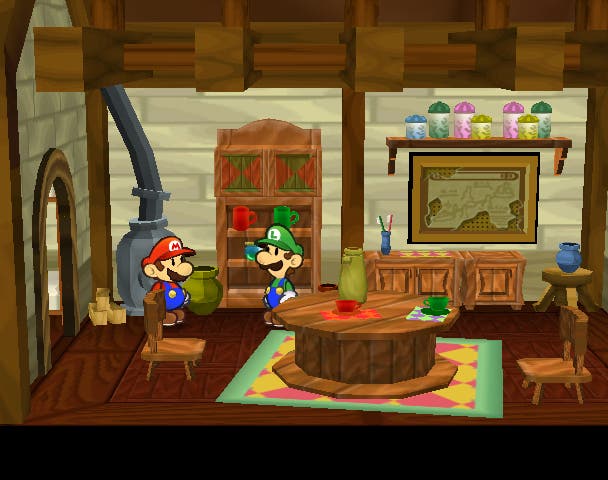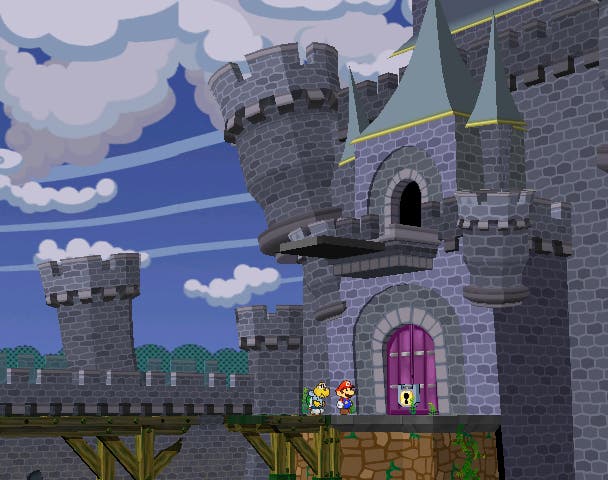Paper Mario 2: The Thousand Year Door
Intelligent Systems can't seem to put a foot wrong. And while we may not understand what's going on some of the time, we know a funny, original and gorgeous role-playing game when we see one, whatever the language barrier...
Order yours now from Simply Games.

Square Enix and co. may have a handle on the serious RPG, but - ignoring green tights and Master Swords - over the past few years Nintendo's quiet little series of quirky Mario-led role-players has done more to excite the minds of its fans than anything on the same format. Super Mario RPG, the original Square/Nintendo crossover, laid the foundations - but it was latter day titles like Paper Mario and Mario & Luigi that developed the concept into something indispensable. And with Paper Mario 2: The Thousand Year Door, favoured first-party Intelligent Systems is arguably working on the first "highly anticipated" title of the bunch. Having spent a few hours with the Japanese version - already a chart-topper in the Far East - we've few doubts that it deserves the publicity.
Picking up a Japanese RPG is always a bit of a challenge when your knowledge of the language begins and ends with Yes and No, so we certainly wouldn't recommend any eager beavers in the audience to jump the gun and order it now. But, having dealt with the important issues - how the save system works, which Japanese characters can be arranged to resemble English words on the naming screen - we managed to struggle through the first few hours and get something of a handle on the plot. And, rather more gratifyingly, the intricacies the battle system - so often the make-or-break factor in many people's RPG love lives, and so often close to infallible in these Nintendo titles.
To begin with though, let's recap what we're dealing with. Paper Mario 2 is a fairly simple RPG with a turn-based battle system. The 'Paper' part of the name is down to the graphical approach, which involves cutout character models, page-turn-style screen wipes and fades and all sorts of other paper-related ideas borne out in a 3D engine that pretends to be 2D. What makes it interesting compared to, say, Final Fantasy is that it doesn't take itself very seriously at all - instead it delights in silly characters, daft jokes (particularly in-jokes - the most renowned being the way everybody recognises Mario but nobody's even heard of Luigi), and above all rewarding and engaging puzzles and combat. The latter in particular has - and will continue to - win plaudits for demanding a bit of skill as well as strategy. But more on that later.
Pulp Fiction

First, let's tackle everyone's reason for being here - the plot. (Okay so it's not really anybody's reason for being here, but how about you let us earn our keep, eh?) At the outset of the game, housewives' favourite Luigi strolls outside and collects the mail from a flying koopa. It's a letter from Princess Peach, he tells Mario. She's in a place called Hoodlum Town - home more or less exclusively to undesirables - where she reports that she's on the trail of a magical bounty called the Legendary Treasure. She encloses a treasure map, and encourages Mario to head along and join her. Having said his goodbyes to his brother, Mario sets off - and when the captain of his ship rouses him on the other side of the opening credits, Hoodlum Town is indeed in sight. Stepping off the jetty though, there's no sign of the Princess.
However there is some commotion up ahead - a young goomba is being accosted by a rather red-faced and rotund fellow with some dodgy milk bottle shades and his band of square-headed minions. Mario, upstanding gent and renowned hero that he is, blunders accidentally into their midst and finds himself thrown into battle. Having taken down his enemy though, Mario and his newfound friend Christina are set upon by a screen-filling horde of minions - literally hundreds in fact - and look done for. Fortunately for Mario though, his enemies' vast numbers give him and Christina a chance to slip out and scarper up the stairs and into town, while a sea of frothing white henchmen struggle to beat up whatever it is that remains in their midst...
Christina, it turns out, is a student at the local university studying archaeology, and it quickly transpires that they're both keen to get their hands on the Legendary Treasure, if only to find out what it is. Christina, inevitably, joins Mario's party, and the pair set off - first to find out what happened to Princess Peach (short version: nobody knows), and secondly to rendezvous with Christina's dopey professor, a man who can help them on their quest. And help them he does. Soon the daring duo are scouring the underbelly of Hoodlum Town in search of the Thousand Year Door, which can only be opened once Mario has collected the seven Star Stones.
Having lit the way on his map and endowed him with a special rejuvenating ability, the Thousand Year Door falls silent - and Mario and Christina soon set off on a quest that will send them to Prairie Town - home of a bunch of koopas downtrodden by a local dragon - and beyond. Knowing the series, the path to the Star Stones will be dotted with familiar faces and winking references. And we dare say Mario and co. aren't the only ones seeking the Legendary Treasure, although - in-keeping with past titles - Bowser is far more likely to become an ally in the face of a greater threat than the usual kidnapper and evildoer-in-chief.
You trod on my lens!

Of course, much as we enjoy it, the storyline isn't the biggest, er, draw in a Paper Mario title. It's entertaining and oft-amusing - and packed full of silly throwaway gags that'll stretch your grin further than ever - but an almost impregnable Japanese copy isn't the best way to get our heads round them. We can see traces of them, mind - our occasional interpreter delighted in explaining how the professor can't remember Christina's name and mistakes the "Kuri" part of her Japanese name for its other meaning: chestnut - but in a sense being unable to read the text is a blessing, because it gives us a chance to concentrate on the visual and audio humour - Mario's little facial expressions, Christina's silly little hat-with-a-torch, a game-show-loving THWOMP's bowtie, and meeting up with a chap who's dropped his contact lens, only to step a couple of feet in any direction and hear a loud crack...
It also gives us a chance to concentrate on the combat. After Mario & Luigi, we were wondering how Intelligent Systems might respond with PM2, and at the moment it looks like the team's brainstorming has worked wonders. As before, Mario fights generally avoidable enemies he runs into on the general play screen in a separate area - and he can gain first-mover advantage by bouncing on their head or whacking them with his mallet, or take a hit first-off if they manage to bash him at first sight - but this time the battle is transplanted onto a stage in a theatre, in front of an audience.
Basic actions are simple to learn and master. Mario and Christina both have head-bounce attacks, and both can be doubled up to strike twice if the player hits A at the precise moment they make contact. Both can also call upon various Flower items; for example, a flower spits fireballs, a POW block knocks over enemies and often kills them instantly, and a Bowser icon casts the perennial bad guy's monstrous shadow over the stage and crowd, frightening weaker enemies into fleeing off the other side.
Mario, meanwhile, can also make use of his hammer - pulling back on the stick long enough to light up the whole of a progress bar, then releasing it to ram the hammer down the throat of whichever bad guy happens to be in the firing line. Christina doesn't have a backup attack like that to begin with, but being a bit of a bookworm she can delve into her satchel and read up on whatever's in front of her, and often identify a weak spot or vulnerability. When Mario first encounters spike-headed stone enemies, for example, it's useful to be able to find out that they're only susceptible to counter-attacks.
Paper Cuts

Counter-attacking and dodging are certainly key to success. By paying close attention to enemy attack animations and hitting A at the right time, Mario, Christina or anybody else in the party can duck out of the way and avoid damage - actually gaining health, in fact. Better, pressing B at the critical moment counter-attacks and has much the same effect as a normal attack - although the window for making use of it is far narrower as a result.
Besides that, Mario can also make use of his Special Abilities as long as he has Star Power. The first of these - Genkigenki! - refills health points and flower points, but in typical Paper Mario style only after our hero has used the analogue stick to hurl stars at icons floating down the screen. It's a useful tool, but obviously it's dependent on Star Power - and that, as you might have guessed, is where the tempestuous crowd lurking in the foreground comes into play. Whenever you land a decent attack - bouncing repeatedly on an enemy's head, for example - the audience rewards you with star points and a bingo card. We're not sure if it's pot luck yet or whether there's some rhythm or rhyme to which cards you receive, but match three and you get to play the slots for a reward - nudging up a mushroom refills all HP, stars deal with Star Power, flowers with FP, and three Shines maximises everything. There is a downside though - if you're unlucky enough to match three poison mushrooms, you'll lose half of your stats across the board.
That's because the audience isn't always on your side. They're happy to cheer you along when you're winning - and you can even waste a turn urging them to back you up and throw more Star Power your way (sometimes they'll even throw items) - but if you're taking more damage than you're dealing out than they may get ugly, and troublemakers lurking in their ranks may throw objects, drop buckets on your head, or even have the stage set collapse on top of your party. Fortunately, if you happen to see one of your hecklers preparing to strike, you can press X to hop down into the crowd and deal them a disservice, and it doesn't take away your turn. Forget to do so though and it could be costly - health points don't grow on trees, after all. They grow on mushrooms.
Battle with Honour and Simplicity

Although we've obviously had only a small taste of what's in store in battle, it's nevertheless a nice balance, and Intelligent Systems seems to know exactly what it's doing. Knowing them, it'll get a lot more complex along the way to the seven Star Stones, and we're looking forward to more Special Abilities - and, given the depths of hand-holding available for anybody who's uncertain of anything, we've little concern that it'll turn out to be too complex. For the most part anything statistical, and any item management, is a doddle to master even in Japanese. You earn Star Points when you defeat enemies - 100 of these and you level up. You collect hidden Star Pieces to spend on Badges, which boost various elements of your arsenal, giving you more proficiency in clubbing people with your hammer, for example. Final Fantasy X's Sphere Grid this is not.
On the other hand, this relative lack of complexity is nothing to worry about either. The game is nicely mixed between traditional RPG battling and village-scouring, the occasional puzzle or memory game and what amounts to a cleverly weighted dose of nostalgia. Bopping blocks to collect coins and hammering trees to find items tickles us a bit - as, particularly, does finding a hidden pipe behind some bushes, ducking down it and emerging in another pipe literally on top of the parallax-scrolling horizon, where we can wander along and hit a blue switch and find a secret Star Piece.
There are hundreds of these little touches even in the first few hours of the game - our favourite would probably have to be the game show face-off with the THWOMP. Just as you expect him to come out and battle you, the screen peels away to reveal the bowtie-wearing brute perched in front of a microphone opposite Mario and Christina in a question box - the whole room decked out in garish neon. Answer a few questions about the game so far - who's the mayor of wherever, how much do these items cost, etc - and Mario can go free. Otherwise it's a showdown with a group of nasty rock-heads, guaranteed to pick their way through your counter-attacks at least a couple of times.
Out of the top draw(er)

As with the original Paper Mario, a lot of this humour and entertainment owes much to the graphical style, which is far and away the most deliciously self-indulgent anybody's attempted on the Cube - Capcom and Viewtiful Joe included. The paper trickery is lovely - the way the screen crumples away, the sides of houses folding down to reveal interiors, and, our favourite, the flick-book effect of a secret bridge spawning out of the blue. Ten years ago it would have just faded in. Five years ago we might have had a puff of smoke. Here the screen flips and flips and flips until we've seen the whole thing built in a flash of page-turns.
Mario's other abilities, too, like his paper aeroplane transformation, owe as much to the visuals as they do to the developer's ingenuity. After unlocking a dodgy fellow in a chest, Mario finds himself cursed with the ability to become a paper aeroplane - literally folding up in midair and floating off into the distance - and, er, travel long distances. That's some curse. Controlling this is a doddle and, cleverly, it looks like your ability to float further will sometimes help you gain access to distant treasures.
The game also makes use of its papery style in other ways. At one point in Hoodlum Town we pointed out that one of the wall textures seemed to be stretching as we walked past it. "That's a bit crap," someone remarked. On closer inspection though, it turned out to be a trick of the perspective - there were actually three walls arranged so that you could only spot the gap between them by watching the relative position of the textures. Hard to explain, but it'll give you a kick when you spot it and reap the rewards.
As will just about everything else in fact - the characters, in particular, are magical little fellows, and they get up to so much. At one point we were discussing the Princess's whereabouts with a wise old villager, all the while a pair of black-suited and bespectacled Delfino types from Mario Sunshine roughed up some locals in the background, leaving them swaying on their feet. Then there's the distinction between koopas - the good ones are clean cut, and the bad ones wear dark glasses and studded collars...
Looks good on Paper
All told, our first few hours with Paper Mario 2 - impregnable language barrier aside - have been filled with the sort of magic and wonderment that we've come to expect from Mario RPGs, and it's easy to see why Japanese critics and gamers have lapped it up so vigorously since its release over there. With the game due out in the States in October and on these shores just a month later on November 12th, we're hard pressed, at this point to think of anything we'd have to say against it. And given we barely understand what's going on some of the time, that's a pretty firm recommendation. As soon as we get our hands on a US copy in a couple of months' time, we look forward to seeing whether we're right about it.
Paper Mario 2: The Thousand Year Door is due out in Europe on GameCube on November 12th.

